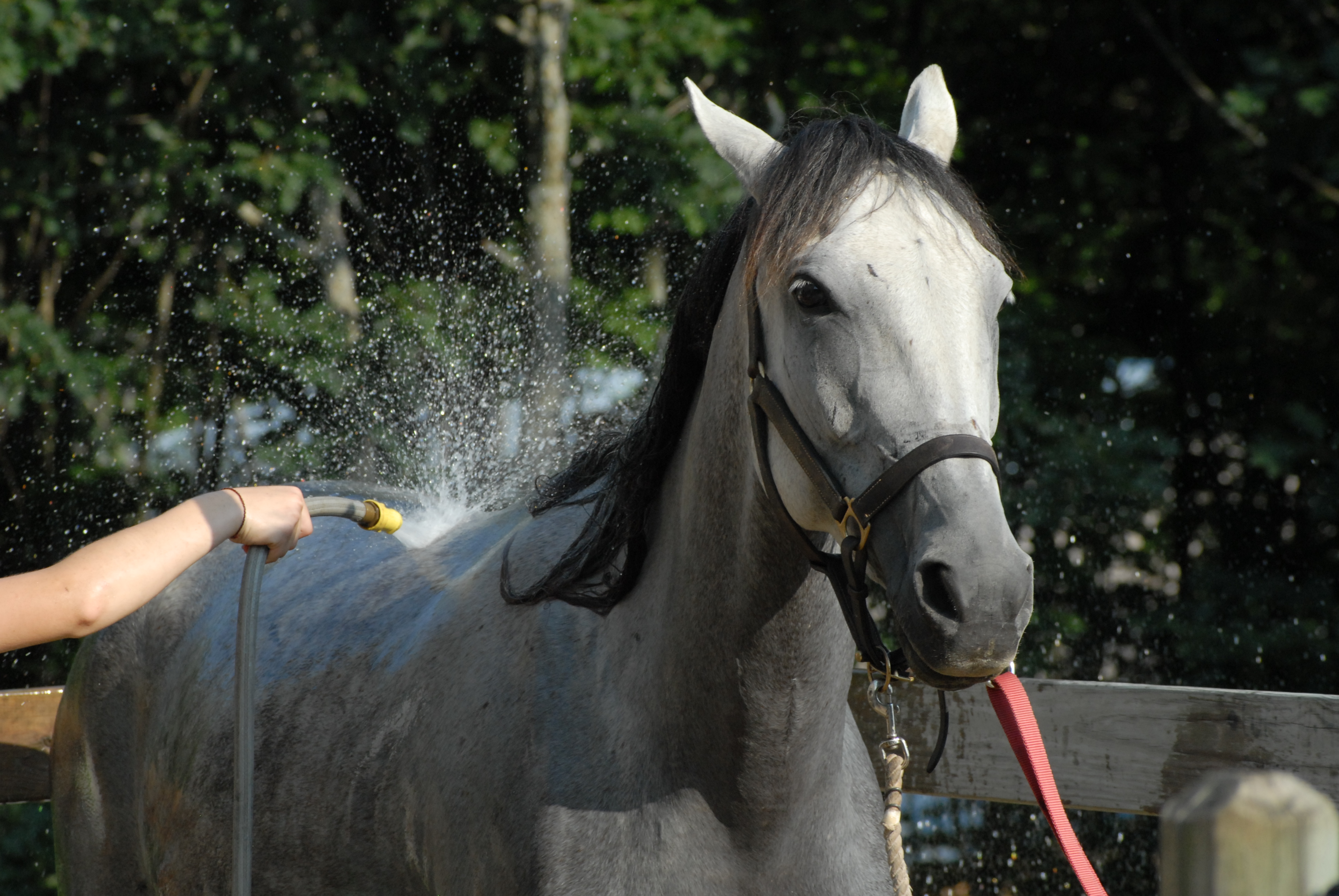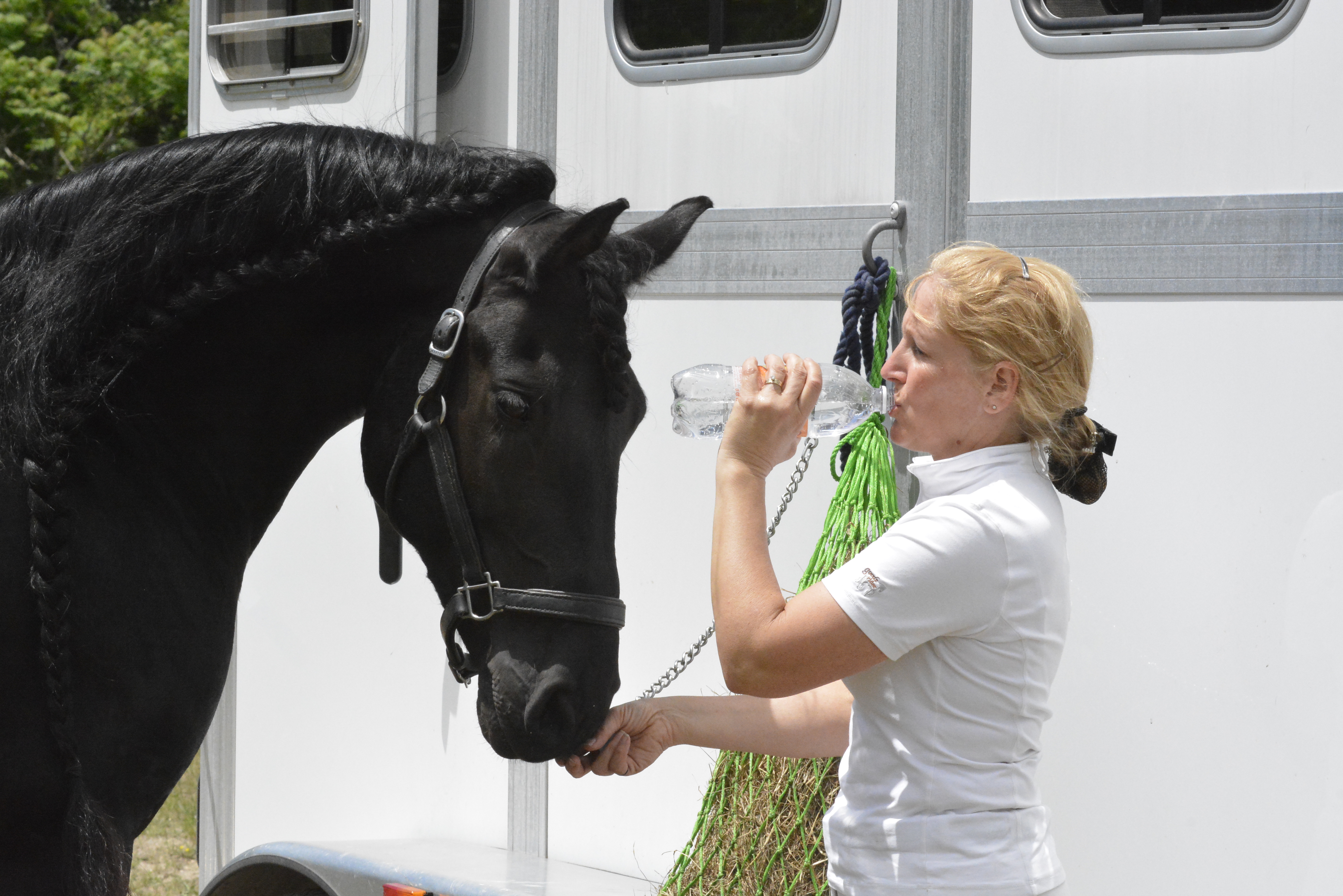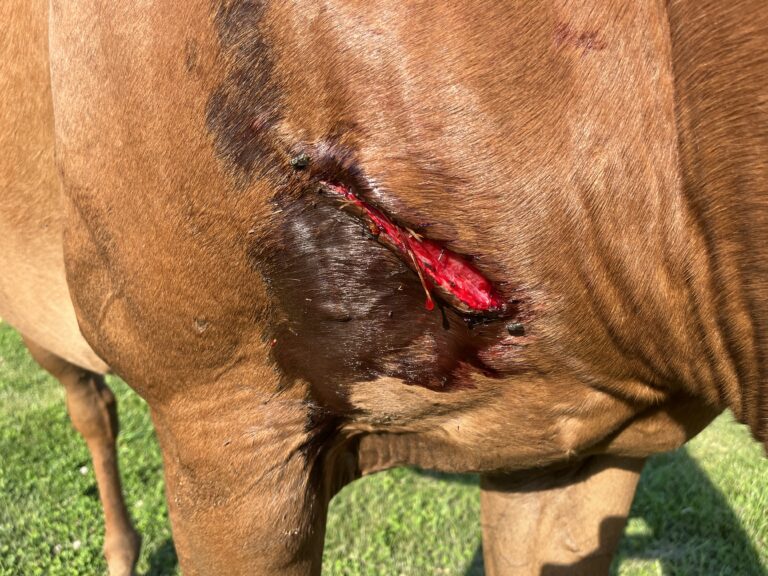Extra free time, annual travel traditions and the promise of fair weather make summertime competitions especially inviting until it just gets way too hot. Riders often comment that it’s not even the heat that’s the problem—it’s the humidity. In fact, there is a lot of truth to this statement. Heat, and especially humidity, pose many challenges and risk factors for both human and equine athletes. While show officials may cancel, postpone or adjust ride times and attire requirements due to weather-related warnings, the reality is that riders often need to use their own judgment about how to compete safely and when to call it off.

When temperatures sizzle and you decide to ride, veterinarian Nancy Loving and medical doctor and USDF gold medalist Beth Glosten say preparation and awareness can help you protect both your own well-being and your horse’s in the heat.
Keeping Horses Safe at
Summer Shows
Loving has served as an FEI-sanctioned veterinarian for endurance riding and as team veterinarian for the USEF National Endurance Squad. Her experience training and competing with her own long-distance horses has informed her veterinary practices. In addition, Loving has competed in dressage and eventing and authored five books on equine health topics, including All Horse Systems Go: First Aid for Horse & Rider and Go the Distance: The Complete Resource for Endurance Horses.
Loving explains that performing in hot and especially humid climates can cause horses to sweat excessively, leading to loss of both body fluids and salt (electrolytes). According to Loving, “Even moderate losses of bodily fluid lead to dehydration, which causes poor skin circulation and less heat dissipation through further sweating, elevations in heart rates and poor recovery. Horse sweat is far more salty than human sweat. Loss of both electrolytes and fluids has significant effects on intestinal activity and on muscle function, potentially leading to synchronous diaphragmatic flutter (commonly known as “thumps”) and myositis (“tying up”). Without effective heat dissipation, the horse may experience heat stress or heat stroke, both of which can lead to serious impacts on all organ functions, including neurologic coordination and mental acuity.”
As dangerous as excessive sweating can be, another condition, anhydrosis, may occur where the sweat glands have exhausted themselves and the horse is unable to sweat to dissipate heat. While not a common condition, it can occur in very hot and humid climates in horses not acclimated to that climate, such as in the southeastern United States.
Loving emphasizes that at summer shows, all steps taken to keep a horse cool and out of the sunshine will help protect his well-being and improve his performance.
Her top five tips for keeping horses cool at summer competitions are:
1. Set up to stay cool by stabling the horse in the shade and in a well-ventilated area throughout the show. Consider using fans to help create cool airflow.
2. Hydrate! Don’t underestimate the importance of water and salt. Provide clean drinking water for your horse at all times. Unless a horse has been performing at gallop speeds, it is OK to let him drink his fill following aerobic-type activities. Loving says it doesn’t hurt to interrupt the horse for a moment if he is guzzling too fast and then let him resume drinking after a short break. Likewise, provide free- choice salt. If your horse is undergoing prolonged exercise, Loving suggests it might be prudent to administer a dose (1 to 2 ounces) of electrolytes (which contain salt, not sugar) by syringe during the event or mix electrolytes into a wet mash for the horse to eat. She explains that depletion of sodium in the sweat causes the thirst reflex to diminish, which may reduce the horse’s instinct to drink enough water. Loving explains, “This is primarily significant to horses who sweat for hours on end, such as those engaged in endurance-type sports.” For most short-term activities, such as dressage warm-up and tests, simply supplying free-choice salt, either as a block or in loose form in a pan should suffice.
3. Soak the horse with cool water over all areas in front of the withers to help keep him cool and comfortable. After soaking, scrape the water off and then apply more water, repeating this process until the horse’s chest is cool to the touch. Loving emphasizes, “In very hot and humid climates, it may be OK to soak the entire body, but in cooler or arid climates, keep water off the hindquarters to prevent tying up.”

4. Monitor vital signs and behaviors before, during and after your ride. Loving suggests checking heart rate before and after exercise to ensure the horse’s heart rate returns to a normal resting rate within 10 to 15 minutes after stopping exercise. If he seems overly warm, his rectal temperature should be checked as well. The horse’s temperature should be less than 103.5 degrees Fahrenheit following exercise and should come down steadily to less than 101 degrees within 20 minutes.
Likewise, check mucous membrane color, capillary refill time and intestinal sounds as part of your overall assessment of how your horse is recovering. (Capillary refill time is a rough indicator of how well your horse’s circulatory system is functioning. It can be taken by applying momentary pressure to your horse’s gum above an incisor and then counting the seconds it takes for the color to return to normal when you release the pressure.) Monitor his appetite and manure output as well as how much he drinks and urinates. Horses who exhibit still-elevated vitals, restlessness, lethargy or who are sweating excessively 20 minutes after exercise may be experiencing signs of heat stress, which warrants medical attention.
5. Prioritize recovery. After your test, hose off your horse’s legs and check for any swellings or scrapes. If you feel it is necessary, apply leg quilts and support wraps to help keep the lower limbs free of swelling following difficult exercise demands.
Keeping Riders Safe and Cool
Dr. Beth Glosten is a USDF bronze, silver and gold medalist as well as an “L” Program Graduate with distinction. She is the author of The Riding Doctor: A Prescription for Healthy, Balanced and Beautiful Riding, Now and for Years to Come and founder of RiderPilates LLC in Seattle, Washington. Prior to retirement, Glosten practiced as an anesthesiologist with a special academic interest in temperature regulation.
Glosten explains that understanding the physiological effects of heat on the human body can help riders prepare to stay safe and ride their best when competing at summer shows. She says three main strategies allow the body to maintain a narrow stable temperature (98.6 degrees Fahrenheit give or take a degree in either direction) for the function of our cells and organs, despite exposure to different environments and activity levels.
According to Glosten, “The body’s first defense is behavior. Think about what you would do if you walked outside on a sunny porch. You would seek the shade for protection from the sun’s rays and you might find a location where there’s a breeze or wave yourself with a fan. These are all behaviors that promote heat loss, which you initiate to protect your body from overheating, maybe without even thinking about it.”
Two other important functions help us stay cool. Changes take place in our cardiovascular system: The blood vessels of the skin dilate (That’s why some people get red in the face when hot). This allows more warm blood to circulate near the skin’s surface, which in turn promotes heat loss to the. environment via convection.
The third body function is sweating, which promotes cooling by heat loss from evaporation of sweat from the skin.
Glosten says, “When you are anticipating competing or riding in the heat, you can use this knowledge of your body’s three cooling mechanisms as a framework to prepare yourself optimally, stay as cool as possible while competing and help your body to recover quickly from the exertion.”
Her top five tips for staying cool when competing are:
1. Get physically fit and pre-hydrate. Glosten emphasizes that getting fit in the months before a competition will improve any rider’s experience, but applies especially when preparing to compete in the heat. She explains, “The physically fit body will sweat more readily during exercise than the body that is not fit. A fit body also creates a sweat that is less salty, so you will be losing less salt through sweat. In this way, you’re accessing your body’s cooling mechanism more quickly and more effectively.”
As the show day approaches, Glosten emphasizes the importance of pre-hydrating. She advises riders: “Arrive at the horse show without a deficit.” This means drinking lots of water in the days leading up to the show and avoiding excessive intake of alcohol and caffeine, which can have dehydrating effects. Good dietary practices in general help with the body adapting optimally to the heat.

2. Recognize and honor the mind–body connection. Being mentally fit may be just as important as being physically fit. Glosten explains, “You will be starting from a better point if you are calm, you have developed tools within yourself to stay focused, you’re not rushed, you’re prepared and you stay organized. You’ll cope more readily with the stressful circumstance of showing in the heat.”
Riders should do what they can to prepare in advance of the show and prevent day-of rushing: for example, by having all paperwork, equipment and apparel in order and ready for use. Glosten points out that a prepared rider can allow herself to get ready for her ride slowly and deliberately, which will likely also help her horse stay relaxed and comfortable—regardless of the weather.
Interestingly, Glosten says the ability to stay calm and accepting of what is happening in one’s environment helps a rider to avoid getting upset about the very fact that she is hot. Getting upset about the circumstance can only add to anxiety, which in and of itself can make a person feel warmer. She advises, “Know that you’re taking care of yourself and remind yourself that you can adjust riding plans as needed to keep yourself and your horse safe.”
3. Be efficient and practical in your warm-up. In general, Glosten recommends an off-horse warm-up (stretching and mindfulness preparation) prior to riding. She says, “Taking time to do some simple mindful movements and stretches can help you organize your body for riding. Then as soon as you sit in the saddle, you are ready to move with your horse, not needing much warm-up for yourself. This contributes to an efficient warm-up for your horse, which is so important on really hot or humid days.”
Once you are in the saddle on a very hot day, Glosten’s advice is simple: trust your training and don’t warm up any more than is absolutely necessary. She says, “It’s easy to use up your energy in the warm-up and be worn out by the time you get to your test. Instead, be really aware of using your time and energy wisely in the warm-up.”
4. Self-monitor throughout the competition. According to Glosten, “At the horse show, you really want to listen to your body. Stay out of the sun when you can. Wear loose-fitting, light-colored clothing. Stay hydrated!” Hydrating means reminding yourself to drink water continually throughout the day—not waiting until you’re thirsty to start drinking.
Glosten also says that if you find yourself working in the heat for more than an hour, it can be helpful to incorporate a sports drink. Look for one that includes both electrolytes and carbohydrates to help the body replenish.
According to Glosten, “The best measure of hydration is what your urine looks like. It should be pale and odorless, not concentrated and stinky. And if you’re not peeing, it’s a problem,” she says.
Likewise, riders should monitor for muscle cramps and fainting or light-headedness, called heat syncope. Both can be strong signs that the body is not adapting well to the heat. Be aware that heat exhaustion—when the body has lost its ability to adapt to the environment—is a serious condition with vague symptoms such as headache, muscle cramps, fatigue, nausea, vomiting and disorientation. A person suffering from any of these symptoms needs to get to a cool place, hydrate and, if symptoms do not improve quickly, seek medical attention.
5. Cool off after riding. Glosten says, “After your ride, you will naturally seek measures that allow you to cool down, such as a cool washcloth around your neck. Honoring these behavioral mechanisms to help your body cool go a long way to expedite a successful recovery.”
Prioritize Well-Being
It is important to recognize that a summertime competition environment can pose special risks to horses and riders, so the well-being of both must always be prioritized. Glosten adds an important final thought: “All of the body cooling mechanisms that are in place for people are in place for the horse. What the horse doesn’t have, however, is the ability to tell us he is thirsty or feeling way too hot. We have to use common sense and watch for signs about how the horse is coping. Likewise, we have controlled the horse’s environment by bringing him to a horse show and, in doing so, taken away his ability to follow his natural behavioral impulses, such as seeking shade or slowing activity. All the more reason to recognize these challenges and make every attempt to prevent heat-related problems with good preparation and horse care.”
This article first appeared in the July 2017 issue of Dressage Today magazine.











